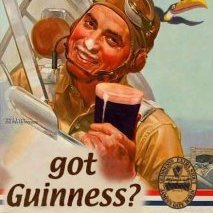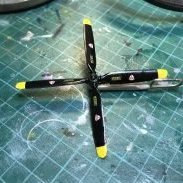Search the Community
Showing results for tags 'Seafang'.
-
Ok, can't let Enzo have all the fun Here's my first entry into this little summertime clam bake. Trumpeters Supermarine Seafang But I daresay it won't be me last.
- 22 replies
-
- 10
-

-
Many years ago when returning to our hobby I built the Supermarine 224, a Rareplanes Vacform that was described as the first Spitfire, photo below. Therefore this GB offers the opportunity to build the last Spitfire, the Seafang, leaving of course a lifetime to complete all the ones in the middle ! I've not built an AZ kit before so this will be a first, pictures below Good luck everyone Cheers Pat
-
The Corsair is still in-the-works (You can follow it here Corsair build log) but its time to start the next one. This is another simple, get-to-be-a-better-builder-before-we-tackle-the-complex/expensive-kits-in-the-stash, so it should be a low-count, good-fit kit and hope fully will not entice to much of detailing and will allow me to horn my skills. Some images first: I was so frustrated with my other build - I had to build something - so I stated with the camera. Image is awful. That's it for now. Ran
-
AZmodel is to re-release (link) it's 1/72nd Supermarine Seafang F.Mk.32 kit - ref. AZ7585 Source: http://www.azmodel.cz/produkt/supermarine-seafang-f-mk-32/ Original boxing ref. AZ.7272 & AZ7300 V.P.
- 6 replies
-
- 3
-

-
- Supermarine
- Seafang
-
(and 1 more)
Tagged with:
-
As follow up to the Spiteful (http://www.britmodeller.com/forums/index.php?/topic/234949742-132-supermarine-spiteful-f14-resin-kit-by-iconicair-released/), Iconicair (http://www.iconicair.com/) is to release in November 2015 a 1/32nd Supermarine Seafang resin kit. Source: http://www.iconicair.com/seafang/ Box art V.P.
-
I was going through my Spiteful/Seafang files yesterday and found these images of the props I'd pulled from another site (I'd right clicked them without really looking at them when I downloaded them). The first image is of spiteful NN664. The blades here look something like the type you may expect to find on a spitfire 21-24 This next set of blades are on prototype Seafang VG471 and remarkably like those supplied by Academy for their MkXIV. They carry the code EXP as far as I can make out. My attempts to measure these blades put them at the same diameter and I calculated 11' 3" by nefarious means so I would suspect they are both 11' rather than 10' 4". Anybody got any thoughts on these blades? Has anybody got the resources to identify them? Thanks in advance, Dave
- 4 replies
-
- Rotol propellors
- Spiteful
-
(and 1 more)
Tagged with:
-
Supermarine Attacker F.1 1:48 Trumpeter The Attacker was Britain's first jet fighter to fly with Fleet Air Arm in carrier operations, and was very much first generation, sharing much of the laminar wing design of the poorly received and short-lived Seafang (Spiteful in RAF service). It was also a tail-dragger, one of the last jets to use that configuration with twin main-wheels under the wings and small tail-wheel under the rear of the fuselage. While this served prop driven aircraft well and kept their props from striking the ground, the jet didn't have this requirement, and the consequential lack of vision from the cockpit over the nose was a real impediment, especially in carrier operations. The RAF rejected the Attacker because it didn't bring anything new to the party, but a navalised version was sold to the Admiralty, although its service life was incredibly short, lasting only three years of front-line service, during which it saw no action. The tail down stance, poor aerodynamics and handling, plus the rapid advance of jet aviation at the time saw it replaced by the Sea Hawk in active service, lingering on until 1957 in Royal Naval Volunteer Service before it was retired completely. Pakistan flew 36 land based aircraft designated Type 538 from 1953 until 1956 when they moved over to F-86 Sabres. The F.1 was the fighter variant, but there were also 11 FB.1 Fighter Bombers that were simply modified as they rolled off the production line to carry rockets and bombs. A later version, the FB.2 was upgraded with newer more powerful version of the Nene engine to give it more speed. A surprising 84 of this variant were built. The Kit The kit represents the initial F.1 variant, and is a welcome release, as previously the only kits in this scale were the competent Falcon vacformed kit and the now defunct Classic Airframes kit. Both could be tricky to build for the inexperienced modeller, and this new injection moulded kit should be pretty simple to build by comparison. It arrives in a standard fighter-sized box with a rather impressionistic painting of an Attacker flying over broken cloud. Inside are three sprues of mid-grey styrene in individual bags, plus a foam wrapped clear sprue in a card "corral", a small sheet of Photo-Etch (PE) parts, a medium sized decal sheet in its own bag, and the instruction booklet, which is landscape A4, and has the paint and decal instructions slipped into the middle. The sprues are well detailed, and have lost of raised and recessed detail moulded into the parts, with a sensible parts breakdown that should make construction straight forward. The inclusion of a set of PE seatbelts is a nice addition, although a few extra parts would have been nice. Shapewise, the parts match the CA kit pretty well, but as I don't have a Falcon kit in the stash, I can't compare with that. The wings of the Trumpeter kit are fractionally smaller in chord, as are the tail surfaces, and the engine intakes start slightly further back on the fuselage, but everything else seems to be "as close as makes no difference" as my dad is prone to saying. Construction starts unusually with the wings, which can be cut to fold the tips for stowage below decks. The lower half of the wing is a single length, including the underside of the fuselage, so seams will need to be filled at the front and rear of this section. The upside is that setting the dihedral of the wing will be a breeze. The gear bays are supplied as single tubs, and have some nice rib detail moulded in. There are a few odds and ends missing from the bays around the gear leg attachment area, but these can easily be added from photos if you're minded to. The upper wings are separate parts, and once installed leave a gap in the centre for the fuselage to be dropped. The cannons are moulded into the lower halve of the wings, with a pair of half-circular cut-outs in the top parts which is an improvement on the old CA kit's resin inserts. The current trend of installing the wheels during the major construction continues with this kit, and the detail is good, having separate oleo-struts, linkages for the gear bay doors, and two parts for the bay doors. The wheels are also nicely detailed, and are moulded in front and rear halves, with the seam hidden by the circumferential tread of the tyres. The wheels are ever-so-slightly smaller than the CA kit, but draw your own conclusions as to who is right there, as I'm not going to venture a guess! The flaps on the wings are separate parts built up from top and bottom halves, and these are glued into corresponding slots on the rear of the wing, split by a small hinge bearing section of wing that extends to the trailing edge. These can be posed at any angle you choose, but check your references to make sure that you do so to the aircraft's permitted range of movement. If you elected for the folded wing-tips, a pair of inserts and an L-shaped hinge are supplied for you to add to the cut wings to set them at the correct angle. The cockpit of the Attacker is a cramped and simple affair, with small side-consoles, a rail for the ejector seat on the rear bulkhead, and a curved instrument panel. The tub is quite nicely appointed, with some instruments and throttle quadrants present, but the throttle levels themselves are absent, making me wonder if they were originally scheduled for the PE fret, but were forgotten about somehow. They can be added using scrap PE and a blob of white-glue for the knob on the end if you see fit, but there won't be much visible once completed. The insides of the fuselage have some ribbing detail present which probably won't be seen either, but it is good that they have added it. A pair of rudder pedals are added to the front of the tub, and a control column just forward of the seat, with a simple black and white decal for the instruments on the main panel. The seat itself is comprised of an L-shaped cushion section, side panels, rear panel with the head-box added from four separate parts, and a set of PE seatbelt straps for the pilot. The Attacker was fitted with a Mark.2 Martin Baker manufactured ejection seat, and this had a slight convex curve to the top of the thigh-guards which isn't present on the kit parts. This can be remedied by a little careful sanding of the parts before gluing together, making reference to one of the many dedicated ejection seat sites out there, so shouldn't be an issue to the informed modeller with a sanding stick. The tail wheel fits into a small box of a bay which is devoid of detail, but hardly likely to be seen anyway. To give the wheel some strength, a flat mounting point is provided, which attaches to the front wall of the bay box. The angled exhaust pipe is supplied as a one-piece part to which a circular fan part representing the rear of the engine is attached. The three assemblies can then be sandwiched between the fuselage halves, with the cockpit coaming added at the same time. A pair of prominent circular intakes are added to the upper fuselage toward the tail, and these are supplied as slide-moulded parts with recessed intakes, which is good to see. The main intakes comprise of a splitter plate and the intake lip itself, one on each side of the fuselage. Both are well detailed with the auxiliary intakes on top of the intakes, and the splitter plates having the support vanes moulded into the back of them, setting the plate away from the fuselage sides. The wings can then be added to the completed fuselage and the seams filled and polished. The canopy is supplied as a two-part assembly, and is crystal clear with very little distortion present. A dip in Klear/Alclad Aqua Klear will improve the clarity further, and the separate windscreen allows the canopy to be posed open or closed as you see fit. The tail-hook, tail wheel doors and the strange instruments on the nose (which are supplied as PE parts) are the last of the mandatory parts, after which only the huge belly tank can be added as an option. This fixes to the underside of the aircraft between the wings, and will hide an awful lot of the fuselage to wing seam, so will be pretty tempting if you're not a fan of sanding and filling. It makes an unusual aircraft look downright strange to me, so could well be a candidate for fitting, just for the hell of it. In British service there is only one scheme, and that is FAA Extra Dark Sea Grey (EDSG) over Sky, with a high demarcation line that cuts through the tail plane line. The rudder is also painted sky, and the nose has a curved demarcation, which will be fun to mask! The usual post-war roundels with the white central ring reinstated are present on the fuselage and the wing tips, and large serials under the wing are also the order of the day. From the box, one of two schemes can be modelled, in the colour scheme above, with the following aircraft: WA496 coded 101, tail code J WP493, coded 106, tail code J Decals are well printed and have good colour density, but I can't help thinking that the red spots on the roundels are ever-so-slightly off-centre. If you agree, you'll need 6 16.5mm roundels to replace them, which although a bit of a pain isn't the end of the world. Conclusion There will be a lot of modellers that are very pleased to see a mainstream injection moulded kit of this important but short-lived early British jet, even though it was a bit poor in reality. It looks to me at least like a pretty good job has been done of it from perusing the sprues. A little more detail in the wheel wells and it should look great with some careful painting. Trumpeter are to be praised for filling in some quite remote nooks of British post-war aviation, as their catalogue expands every year to include some oddities that we'd never expected to appear in injection moulding. Highly recommended. Review sample courtesy of







